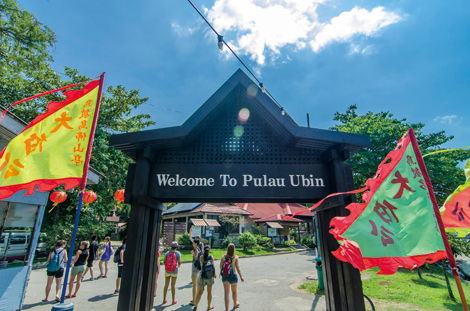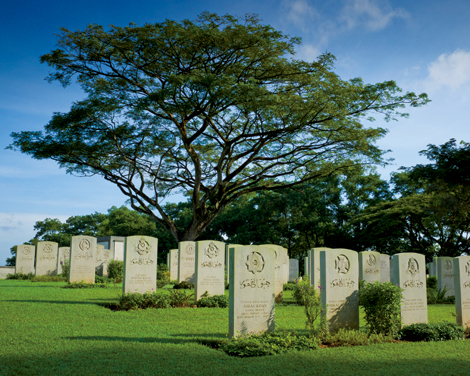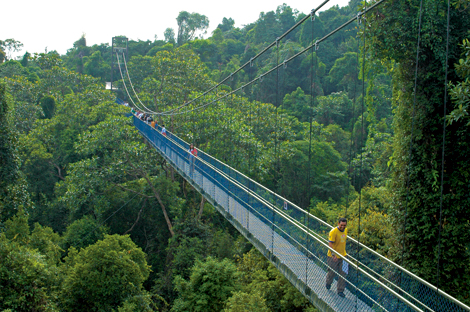Though most travellers know Singapore as an urban jungle complete with skyscraping office towers and shiny futuristic-looking megamalls, there is another side to the city that invites one to step away from modernity and reconnect with nature. If you have some spare time and are looking to escape the hustle and bustle of city life, stretch your legs, get some fresh air, take some photographs or enjoy the country’s biodiversity, then these spots are certainly worth exploring. Whether it’s visiting farms in the countryside, observing wildlife in a mangrove swamp or trekking through a rainforest, Singapore’s rustic side presents a refreshing new way to enjoy your time there.
Pulau Ubin

This small boomerang-shaped island to the northeast of Singapore is the last kampung – traditional Malay style rural village, in the country. Exploring this 10.2 square kilometre island is like travelling back in time to the Singapore of the 1960s, when life was simpler and people moved at a slower pace. There are still about a hundred villagers living here, and many still rely on subsistence farming, wells for their water supply and diesel generators for electricity.
The island was once a granite mining area that contributed to the livelihood of a few thousand settlers, so the terrain now comprises a series of undulating granite hills. Today, abandoned granite quarries create dramatic picturesque landscapes, while secondary forests and grasslands imbue the island with a wild frontier spirit.
Things to see and do
When you get off the boat at Ubin Jetty, head west and you’ll arrive at Ubin Town where there are some very good eating establishments such as Pak Ali’s satay stall selling tasty barbeque skewered meats. You’ll also find bike-rental shops and family-owned convenience stalls in the town. Stop for a snack and perhaps a fresh coconut juice before exploring the island. Look out for the wayang stage in the centre of the town, where traditional village performances were once held, as well as the Tua Pek Kong temple.
If you want to get some exercise, walk or cycle through quiet, peaceful roads lined with swaying coconut tees, or take to a shady dirt trail in a rubber plantation. To get a good 360-degree perspective of Ubin island life, get on the Pulau Ubin Tree Trail, an off-the-beaten-track experience that will take you through old rubber and coconut plantations, past several interesting trees such as the candlenut and attap palm tree, and the house of the late village headman, before ending at an enchanting Tudor-style heritage house. If you’re in the mood to take it easy, then bring a book, a towel, and simply unwind on one of the secluded beaches.
On the eastern tip of Pulau Ubin are the Chek Jawa wetlands, about a 40-minute hike from Ubin Jetty. Six diverse and rich wildlife ecosystems – mangroves, sandbars, corals, seagrass lagoon, rocky shore and coastal forest, meet here, providing a habitat for millions of animals, marine and plant life. Walk along the one-kilometre long boardwalk and look out for starfish and crabs. If you’re lucky, you might even spot a wild boar. Ideally, you should start your journey in the morning and catch an early evening ferry back to the main island.
How to get there
Take bus numbers 2, 29, 59 or 109 to Changi Village Bus Terminal. From there, it’s a short 100-metre walk to Changi Point Ferry Terminal, where you can take a bumboat to Ubin Jetty. The ferry ride is just 10 minutes and a single trip costs S$2.50 (US$2). From Ubin Jetty, it’s a 40-minute walk, or 20-minute bike ride to Chek Jawa.
Opening hours
Chek Jawa is open from 8.30am to 6pm daily. Admission is free.
Kranji Countryside
Nourished by the Kranji Reservoir, Kranji Countryside in the northwest corner of the island is Singapore’s last agricultural bastion, and a place where you can visit farms, fisheries, historical sites and experience an almost forgotten agrarian way of life.
By the 1960s, Singapore’s rapid urban development meant that new residential neighbourhoods replaced much of the country’s arable land. As a result, today more that 90 percent of Singapore’s food is imported, and the 710 square kilometre island-nation has only 100 hectares of farmland, with farmers making up less than one percent of the population.
To conserve and raise awareness for this small but precious aspect of Singapore’s heritage, a group of visionary farmers formed the Kranji Countryside Association (KCA) to promote local agriculture and environmental sustainability. Their efforts have transformed the Kranji Countryside into a leisure and educational hotspot, where visitors can learn about local farming practices, engage with the farmers, enjoy good food, and purchase farm produce. Give yourself at least half a day here, as there is much to see, do, eat and buy.

Things to see and do
There are close to 40 farms here, including fisheries that raise koi, farms where frogs, crocodiles and fireflies are bred, dairy farms, egg farms, orchid nurseries, agro technology farms, and organic vegetable farms. Currently, 10 of these are open to the public. Follow a heritage trail and stop by these farms to learn about farming techniques and processes on an educational tour. Enjoy a wholesome lunch at one of the area’s enchanting little restaurants such as Poison Ivy café at Bollywood Veggies (+65 6898 5001, bollywoodveggies.com), which serves local and international fare using farm fresh produce, as
well as batches of delicious homemade banana bread.
Also located within the area is the Sungei Buloh Wetland Reserve – a 130-hectare wildlife-protection zone with mangroves, mudflats and rainforests that is home to a variety of flora and fauna and many rare species of migratory birds. If you’re thinking of spending the night in the area, check into the D’Kranji Farm Resort (+65 6898 9228, dkranji.com.sg), where you can get your own cosy little villa with a balcony. The resort is also home to a “fishing village” where you can fish for prawns at S$18 (US$14) an hour, plus the Swiflet Garden Museum where you can learn all about the Asian delicacy of birds’ nest.
By introducing the concept of “agritainment” to the countryside, KCA farmers hope that visitors will gain more insight into where food comes from, become more environmentally aware, and ultimately help bring new life back to Singapore’s farms.
For history buffs, the area is also rich in WWII reminders, such as The Kranji War Memorial, home to a peaceful cemetery with more than 4,000 graves and stone memorials inscribed with the names of thousands of soldiers from all over the world. Other historical points of interest in the area include Thow Kwang, one of the last surviving “dragon kilns” in Singapore that has been used to fire ceramic products since the 1940s.
How to get there
Take the MRT train to Kranji MRT station, then catch the Kranji Express bus from there.
Opening hours
Visit kranjicountryside.com/faq.html to find out the opening hours for individual farms. Sungei Buloh Wetlands Reserve is open from 7.30am to 7pm.
MacRitchie Reservoir Park
A well-loved destination among Singaporeans for exercise, cross-country runs and family walks, MacRitchie Reservoir is a slice of serene emerald paradise in the heart of Singapore. Constructed in 1867, MacRitchie Reservoir was Singapore’s first impounding reservoir, and was built in response to the island’s growing need for fresh water. It was enlarged in 1891, and renamed Thomson Road Reservoir in 1907, before finally being renamed as MacRitchie Reservoir in honour of James MacRitchie, the engineer who designed and built it.
MacRitchie Reservoir Park serves as a gateway to the city’s nature reserves and is a popular spot for kayaking, leisurely strolls, picnics or early morning marathon training sessions.
Equipped with amenities including toilets, showers, lockers, drinking fountains, food kiosks and eateries, it’s a terrific destination to explore nature at your convenience. It’s easy to spend a few hours here. There are more people here in the morning and evening, so come in the afternoon if you want more peace and quiet.
Things to see and do

Enjoy a bird’s-eye view of tropical rainforests as you walk along the 250-metre Treetop Walks – an aerial freestanding suspension bridge that spans the two highest points within the park. There is also an 11km walking trail loop known as MacRitchie Trails, as well as a variety of shorter trails that will take you deep into the heart of the jungle. Look out for squirrels, long-tailed macaque monkeys, monitor lizards or even flying lemurs and owls. Listen to birdsong as you leave the world behind and lose yourself in this tranquil, verdant oasis.
If you want to stay closer to the water, rent a kayak from the parks Paddle Lodge and glide along the jade green water, or enjoy a slow meditative stroll along the wooden boardwalk along the water’s edge as you watch turtles basking in the sun and macaques grooming their young. After a good hike, you can fuel up on local favourites such as laksa (curry soup noodles) or beef stew with rice at Mushroom Café, or kick back with a cocktail at Vava Bistro (+65 6353 3220, vavabistro.com.sg).
How to get there
Several buses stop on Lornie Road in front of MacRitchie Reservoir Park. If you are departing from Orchard Road, take bus 132 or 167. You can also take the Mass Rapid Transit (MRT) and alight at Marymount station, then walk for about 2km.
Opening hours
The park is open from 7am to 7pm. Admission is free.
The Southern Ridges
To see as much of Singapore’s natural beauty as you can, spend the day walking along the Southern Ridges, a 10km green space that connects Mount Faber Park, Telok Blangah Hill Park, HortPark, Kent Ridge Park and Labrador Nature Reserve. This is a great way to enjoy panoramic views of the city, harbour and the Southern Islands. Walk across Henderson Waves, a 36-metre high wave patterned bridge and feast your eyes on spectacular views of the southern section of Singapore. It takes about five hours to complete the entire Southern Ridges walk from Harbour Front MRT station to West Coast, but there are shorter trails to choose from.
Things to see and do
There are eight trails at the Southern Ridges, which will take you through the various parks. Each of these has its own unique character. At the peak of Mount Faber is a cable-car station and recreational area called Jewel Box with restaurants, gift shops and viewing decks.
Telok Blangah Hill Park was once the gathering place for trading communities, which flourished here in the early nineteenth century. A symbol of the prosperity of that time is embodied in Alkaff Mansion, a regal colonial bungalow built by an Arab trader, which now serves as a venue for weddings or events. Get a DIY foot massage as you walk on the reflexology footpath here, or simply enjoy a panoramic view of the city from the park’s Terrace Garden.
If you have a green thumb, give yourself at least an hour or two at HortPark, a one-stop hub for everything related to gardening. Join a guided tour or workshop to learn about how to get rid of weeds or perhaps how to plant orchid bushes, or have a look at the variety of plants, flowers and grubs that grow in Singapore.
Kent Ridge Park has the highest number of fitness stations of any park in Singapore, so it’s a good spot for some quick strength training. There are also various lookout points here that offer magnificent views of the small islands surrounding Singapore. The park is home to tembusu and acacia trees, many exotic species of birds and insects, as well as pitcher plants and wild orchids. On the eastern side of the park is a pond with turtles and Japanese koi. Also located here is a hill where the last battles to defend Singapore during World War II were fought.
In Labrador Nature Reserve, you can listen to the songs of oriental magpie-robins and black-naped orioles as you keep an eye out for squirrels jumping from tree
to tree. This park, which has 70 varieties of birds and 11 species of butterflies, will delight nature lovers, while war relics such as guns and secret tunnels will thrill history aficionados. Take a walk along the boardwalks of Berlayer Creek mangrove trail and the foothill of Bukit Chermin and observe the fauna and flora that inhabit this coastal habitat. If you’re here at dinner or lunchtime, treat yourself to exquisite Thai food at Tamarind Restaurant (+65 6278 6364, tamarindrestaurants.com).
How to get there
For information on how to access the various trails, visit nparks.gov.sg
Opening hours
HortPark is open daily from 6am-10pm. The other parks and nature reserves are well lit enough for safe walking from 7am to 7pm daily.












